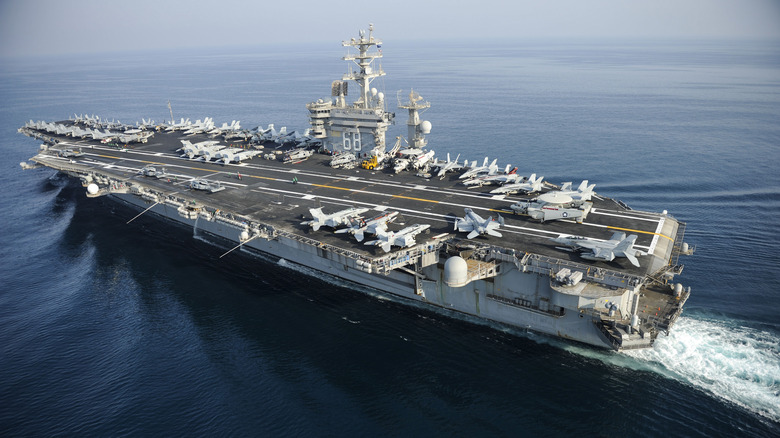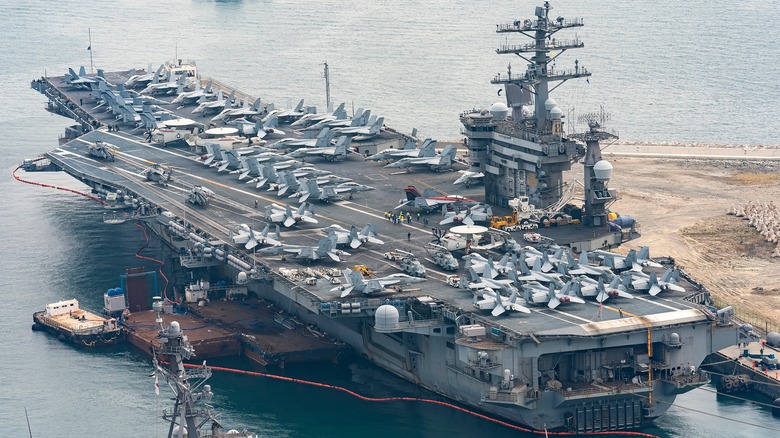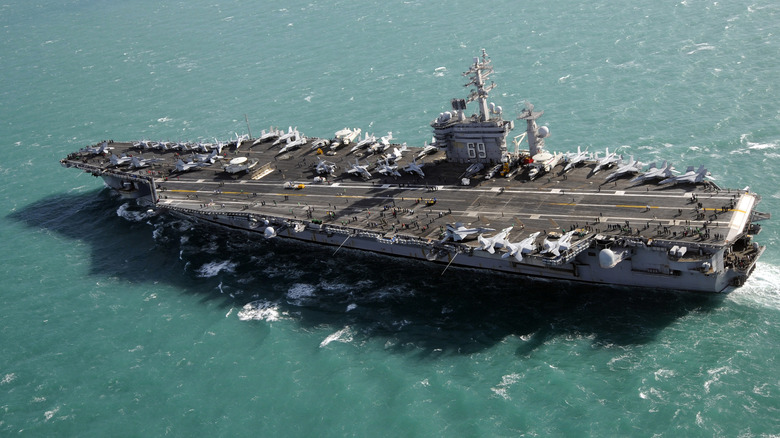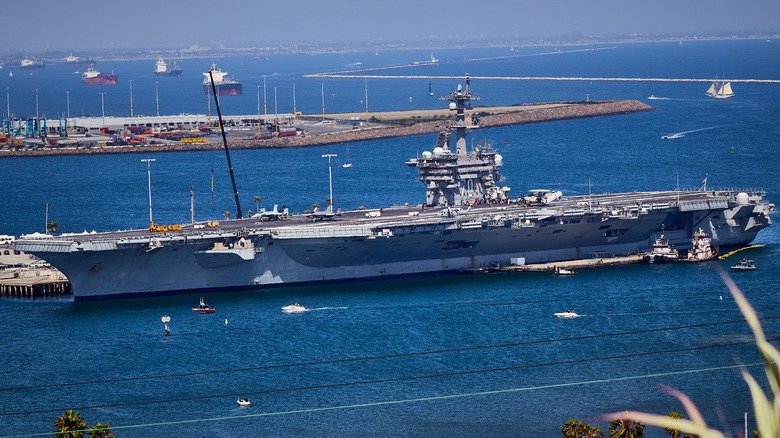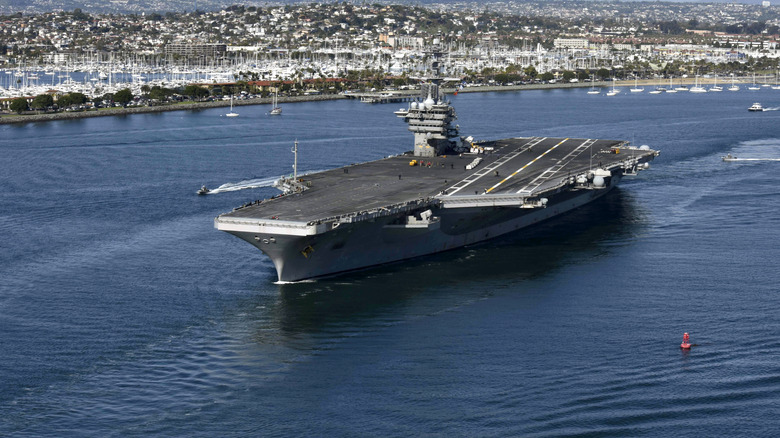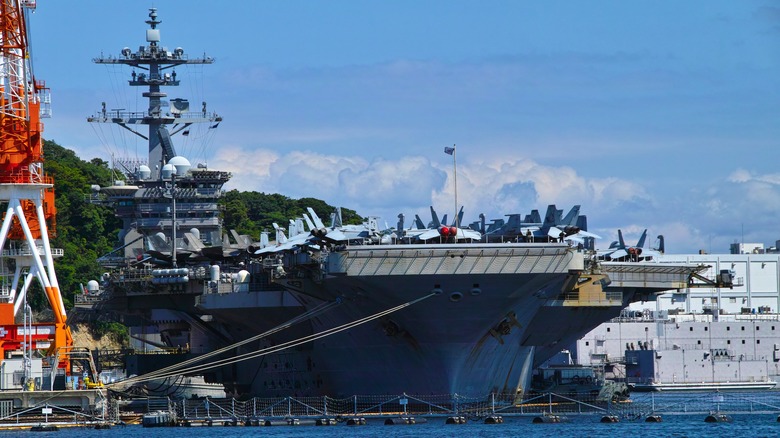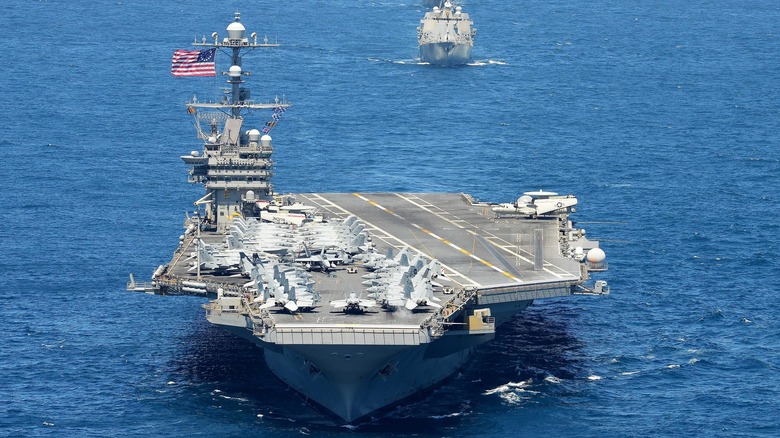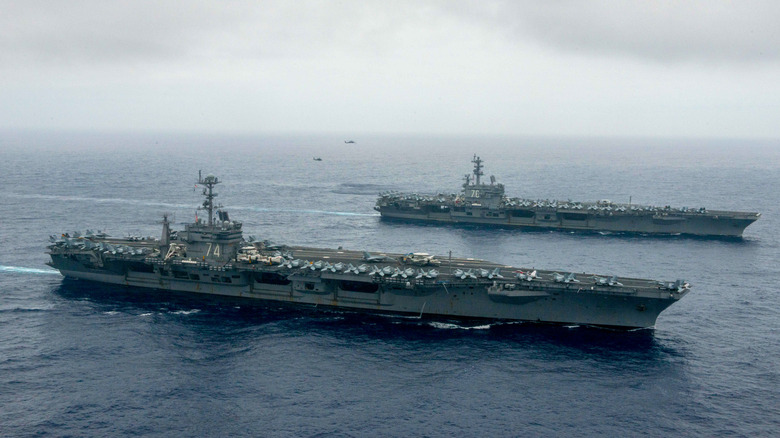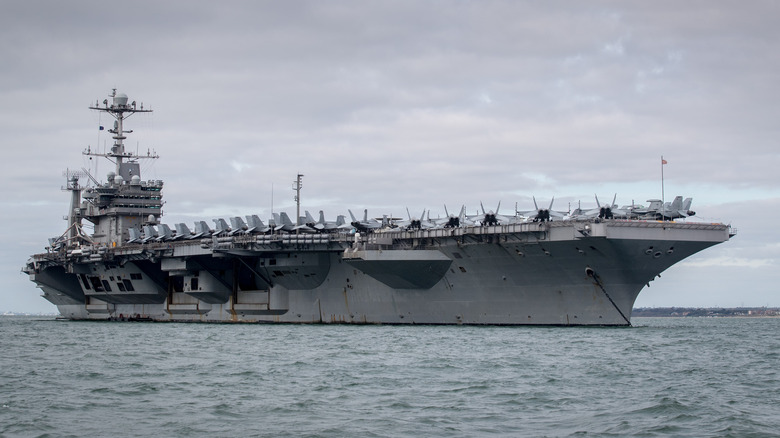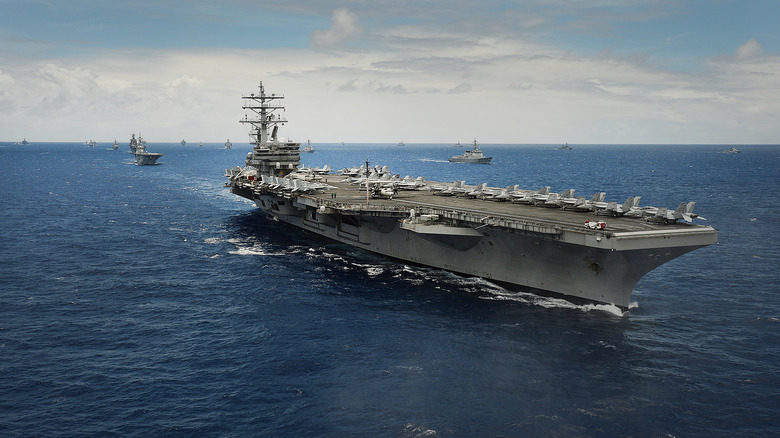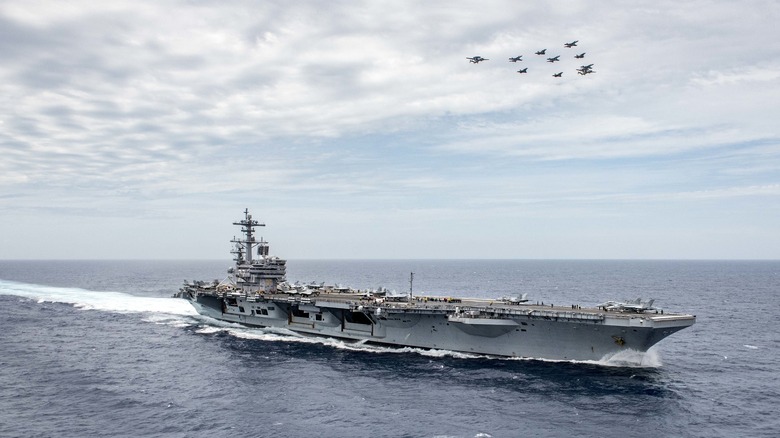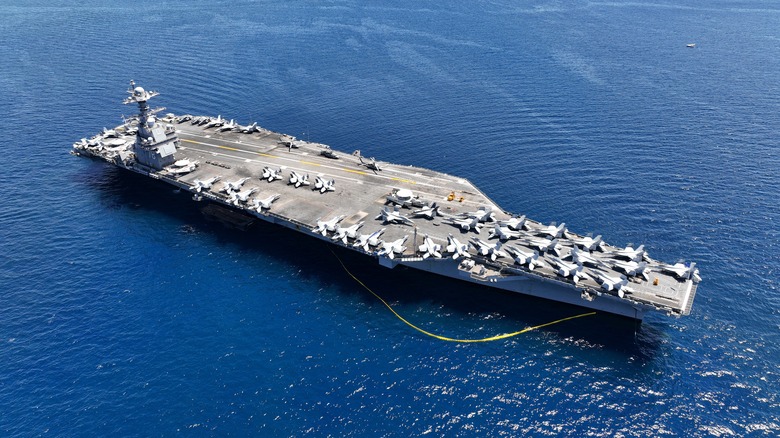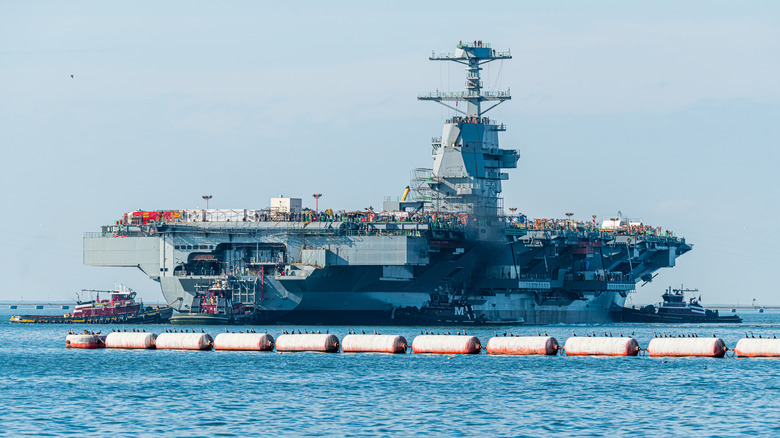Every Active Aircraft Carrier In The US Navy As Of 2024
Aircraft carriers are large ships that lug around warplanes, ready to launch into dogfights at a moment's notice. But calling an aircraft carrier a mobile runway and hangar is like calling a cruise ship a floating hotel.
Aircraft carriers have been around since 1922. Sort of. Technically, the first US carrier, the USS Langley, was a modified Proteus-class cargo vessel and was nothing more than an unarmed test bed. If you only count ships built from the ground up to serve as aircraft carriers, then the first true US Navy carrier was the USS Ranger, commissioned in 1934.
Modern aircraft carriers are some of the largest ships in any naval fleet and tend to dwarf most other vessels, but that also means they're expensive to build and maintain. To make matters worse, weapon technology has advanced so much that some military analysts wonder whether carriers are even worth the time and money.
As of writing, only 47 aircraft carriers remain active worldwide, operated by fourteen navies. Of these 47, 11 belong to the US Navy and are divided between two different classes: the Nimitz and the Ford. To avoid confusion, we did not count amphibious assault ships among these 11, despite their ability to house VTOL jets. Here are all the aircraft carriers the US Navy currently uses.
CVN-68: Nimitz
As is Navy tradition, the first vessel in a new line of ships shares the same name as its class, so the first Nimitz-class aircraft carrier was named the USS Nimitz. It is also known as CVN-68, meaning it is the 68th carrier ship built for the US Navy – the "CV" indicates it is an aircraft carrier, and the "N" designates it as nuclear-powered.
The Navy began constructing the Nimitz in 1968 in Newport News, Virginia, and finished in 1972. While many Nimitz-class carriers are named after presidents, the class itself honors Fleet Admiral Chester W. Nimitz, who led the US Pacific Fleet during World War 2. The Nimitz is 1,092 feet long, technically making it (and every Nimitz-class ship) a "supercarrier." Moreover, the USS Nimitz is fueled by two nuclear power plants and boasts four catapults to launch planes.
In 1976, the Nimitz received its first deployment and traveled to the Mediterranean Sea. One year later, the ship was sent on a rescue mission to the Indian Ocean after Iran took 52 US hostages. The ship's most noteworthy deployments occurred in 2003 and 2005 when it was sent to the Persian Gulf to aid in Operation Iraqi Freedom (aka. The Iraq War).
While the USS Nimitz is currently active, it is scheduled for retirement. The carrier will be removed from battle forces starting the fiscal year 2025, and its true decommission should start sometime in 2027.
CVN-69: Dwight D. Eisenhower
The USS Dwight D. Eisenhower, or CVN-69, is the second Nimitz-class ship. This vessel was launched in 1975 but didn't receive any actual deployment until 1978.
Like other Nimitz-class carriers, the Dwight D. Eisenhower shares the same body plan and was built in Newport News, Virginia. On a side note, the USS Dwight D. Eisenhower marks the first time any Navy vessel was named after President Dwight D. Eisenhower.
The USS Dwight D. Eisenhower's first assignment was to the United States Atlantic Fleet. Later, in 1980, the vessel was sent to the Indian Ocean in response to the Iran hostage crisis. After Iraq invaded Kuwait, the Dwight D. Eisenhower also became the first carrier to provide sustained support within the Red Sea. In 1991, the ship sailed to the Persian Gulf and became a crucial contributor to Operation Desert Storm. Afterward, the USS Dwight D. Eisenhower provided support for US operations in Iraq and helped enforce the No-Fly Zone over the country (Operation Southern Watch).
As with the USS Nimitz, the USS Dwight D. Eisenhower is quickly approaching its expiration date. The ship is scheduled to be decommissioned in 2029, at which point CVN-80, also known as the USS Enterprise, will replace it.
CVN-70: Carl Vinson
The third Nimitz-class supercarrier, the USS Carl Vinson (CVN-70), was named after former Georgia Congressman Carl Vinson. He created the Two-Ocean Navy Act, the largest naval procurement bill in US history.
The USS Carl Vinson was commissioned in 1982. Like other Nimitz-class vessels, the carrier is staffed by 3,000 sailors who keep the ship running smoothly, from preparing meals to maintaining the nuclear reactors. These workers are augmented by another 2,000 sailors in charge of aircraft flight and maintenance.
Out of all the Nimitz-class carriers, the Carl Vinson has some of the most noteworthy deployments under its belt. The ship participated in Operation Desert Strike (the 1996 missile strikes on Iraq), Operation Iraqi Freedom, and Operation Enduring Freedom (the Osama bin Laden compound raid). Osama bin Laden was even buried at sea on the Carl Vinson's deck. Not all of the USS Carl Vinson's accomplishments involve military operations, though. On November 11, 2011, the Carl Vinson hosted the first NCAA basketball game played on an aircraft carrier. The match was between the North Carolina Tar Heels and the Michigan State Spartans.
While the USS Carl Vinson's decommission has yet to be announced, all Nimitz-class vessels have an estimated lifespan of around 50 years, so the carrier has quite some time left. However, it will eventually need to be replaced.
CVN-71: Theodore Roosevelt
Most Navy vessels that make a name for themselves do so by taking part in important missions and operations. However, some, such as the USS Theodore Roosevelt, enter the history books because of what went on in the background before and during construction.
The USS Theodore Roosevelt (CVN-71) was obviously named after President Theodore Roosevelt, and this name also affected the ship's other identifiers. The aircraft carrier is nicknamed "The Big Stick," after President Theodore Roosevelt's famous phrase, "Speak softly, and carry a big stick." Moreover, the ship's call sign is "Rough Rider," after the volunteer cavalry regiment Roosevelt led during the Spanish-American War.
Unlike prior Nimitz-class ships, the Theodore Roosevelt faced tumultuous executive decrees before its construction could start. In 1976, President Gerald Ford canceled plans to construct future Nimitz-class ships and tried to supplant them with "CVV" ships – smaller, cheaper aircraft carriers that ran on conventional fuels. These ships were never built. And in 1978, President Jimmy Carter vetoed plans to build more Nimitz-class carriers. However, after the Iran hostage crisis, President Carter backpedaled his decision. To build the Theodore Roosevelt, the Newport News shipyard used the then-new modular construction technique. The ship was built independently in sections (i.e., modules), and once they were finished, the sections were welded together.
Modular construction has become standard across the Navy shipbuilding industry, and we have the USS Theodore Roosevelt to thank.
CVN-72: Abraham Lincoln
After the USS Theodore Roosevelt's construction woes, it was back to business for shipwrights at Newport News, Virginia. The first order of business, building a Nimitz-class ship named after the Great Emancipator.
In 1984, construction began on CVN-72, a.k.a. the USS Abraham Lincoln. The ship was officially commissioned in 1989, and its first deployment was to aid in Operation Desert Storm. However, the Abraham Lincoln had to abruptly change course (and gears) to support the evacuation of Luzon Island after Mount Pinatubo erupted. This mission, Operation Fiery Vigil, has gone down in history as the largest peacetime evacuation carried out by active military personnel.
After this rescue, the USS Abraham Lincoln participated in several other important assignments, such as Operations Southern Watch, Vigilant Sentinel (when Saddam Hussein tried to invade Kuwait), and Enduring Freedom. When not on active duty, the aircraft carrier occasionally hosted film crews. You might recognize the Abraham Lincoln from movies such as Stealth and The Core. This makes it the third Nimitz- class ship to guest-star in a motion picture, after the USS Carl Vinson ("Behind Enemy Lines") and the USS Nimitz ("The Final Countdown").
Currently, the USS Abraham Lincoln is stationed off San Diego and recently opened a USO Center where sailors can make phone calls, watch movies, and play video games.
CVN-73: George Washington
Some Nimitz-class aircraft carriers are known for participating in foreign wars. Others, such as the USS George Washington, are better known for being stationed in areas that, while not active warzones, are critical nonetheless.
The USS George Washington (CVN-73) is the sixth Nimitz-class nuclear-powered aircraft carrier built by the US Navy and was, quite obviously, named after the first President of the United States. Construction began in 1986, and the ship was christened in 1990. While the vessel took part in several training missions and deployments in the following years, the George Washington's first major mission occurred on September 11, 2001, when the ship was deployed to New York waters to shoot down terrorist-piloted planes.
In 2005, the US Navy announced that the USS George Washington would sail to the Yokosuka Naval Base in Yokosuka, Japan, and replace the aircraft carrier stationed there, the Kitty Hawk-class USS Kitty Hawk. Not only was this decision part of the Navy's attempt to supplant aging vessels with newer models, but it also marked the first time a nuclear-powered ship was stationed outside US waters. Since Japan and its citizens are legendary in their anti-nuclear stance, to put them at ease, the US Navy commissioned a manga to help explain the situation. No, seriously.
As of writing, the USS George Washington is undergoing repairs to fix "significant damage" to its generators.
CVN-74: John C. Stennis
Aside from the USS Nimitz and the USS Carl Vinson, almost all Nimitz-class aircraft carriers were named after US Presidents. The USS John. C. Stennis is the final exception to the tradition, but this decision has caused some concerns.
CVN-74, also known as the USS John C. Stennis, was named after Senator John Stennis. Like Congressman Carl Vinson, Senator Stennis was likely chosen as the namesake due to his connection to the armed forces — he supported a strong military and was nicknamed the "Father of America's Modern Navy." Construction began in 1991, and the ship officially launched in 1993.
The John C. Stennis has been the center of many important missions, non-military activities, and one ongoing controversy. This carrier was the first ship to host the F/A-18E Super Hornet, and the USS John C. Stennis also participated in the missions Operation Southern Watch and Enduring Freedom. In 2001, the ship was converted into an outdoor theater to premiere the film "Pearl Harbor." Unfortunately, the John C. Stennis recently came under fire. In 2020, retired US Navy Lieutenant Commander Reuben Keith Green argued that the USS John C. Stennis should be renamed because Senator Stennis was a segregationist who signed the "Southern Manifesto," a document that tried to reverse the Brown v. Board of Education Supreme Court ruling.
While the fight to rename the USS John C. Stennis is ongoing, the ship's overhauling will be completed in October 2026.
CVN-75: Harry S. Truman
As previously stated, all Nimitz-class aircraft carriers were built using modular construction after the USS Theodore Roosevelt. The building went fairly smoothly until the seventy-fifth aircraft carrier.
Construction on the USS Harry S. Truman (CVN-75) began in 1993 and launched in 1996. The vessel was named after the thirty-third President of the United States, and during the commission speech, then-President Bill Clinton mirrored President Truman's famous words by stating the US "must continue to be responsible, to say the buck stops with the United States." Unfortunately, three Newport News shipbuilders died during construction. The cause of death was exposure to methane and hydrogen sulfide gasses, as well as sewage leakage.
Before the USS Harry S. Truman departed for its first mission, the ship hosted the US Navy Blue Angels, the first time any Blue Angels jet landed on an aircraft carrier. Throughout the years, Harry S. Truman participated in numerous missions, including Operation Southern Watch, Operation Iraqi Freedom, and Operation Inherent Resolve (the campaign against ISIS).
The USS Harry S. Truman deployed to the Mediterranean Sea when Russia Invaded Ukraine
The USS Harry S. Truman deployed to the Mediterranean Sea when Russia invaded Ukraine in 2022, but it apparently left with incorrect supplies. Rear Admiral Phillip Sobeck blamed "bureaucracy."
CVN-76: Ronald Reagan
Most namesakes didn't live to see the completion of the Nimitz-class aircraft carriers named after them. The only exceptions were John Stennis, George H.W. Bush, and Ronald Reagan.
The USS Ronald Reagan (CVN-76) began construction in 1988 and was christened in 2001. While President Ronald Reagan was alive during the ship's commissioning and launch, he was unable to attend due to his Alzheimer's. He died barely a year after the carrier was commissioned, and a funeral was held on the ship's deck.
In 2006, the USS Ronald Reagan was sent to aid in Operation Iraqi Freedom, but the ship's mission started poorly. A few weeks into deployment, 1,900 pounds of jellyfish were sucked into the ship's condensers, clogging them and preventing the reactors from properly cooling. A day or two later, an F/A-18 Hornet crashed into and skidded off the flight deck during a training exercise. Thankfully, the rest of the carrier's service was less eventful. Mostly. In 2007, the Ronald Reagan underwent surge deployment to replace the USS Kitty Hawk in Yokosuka, Japan. Shortly afterward, the USS Ronald Reagan provided humanitarian aid for the victims of Typhoon Fengshen. The Ronald Reagan returned to Japan in 2011 to provide disaster relief after the infamous magnitude 9.0 earthquake hit the country, and again in 2015 to make Yokosuka, Japan, its homeport.
In May 2024, the USS Ronald Reagan departed Yokosuka to perform one final Indo-Pacific patrol.
CVN-77: George H. W. Bush
All good things must come to an end, including the Nimitz-class aircraft carrier line. The USS George H. W. Bush (CVN-77) is the tenth and final supercarrier in the Nimitz-class.
Construction of the USS George H. W. Bush began in 2003. Unlike most Nimitz-class ships (except for the USS Ronald Reagan), the George H. W. Bush was built with updated technologies and designs. These included a more buoyant bow, underwater hull-coating, new propellers, and a superior sewage system.
While the USS George H. W. Bush didn't see much action during its first few years, the carrier provided a series of firsts for the US Navy. For instance, the George H. W. Bush was helmed by the first woman to lead a carrier strike group, Rear Admiral Nora W. Tyson. Moreover, in 2013, the ship served as a testbed for new torpedo self-defense systems, and it was also the first carrier to launch an unmanned aircraft, specifically the X-47B drone. After these tests, the USS George H. W. Bush participated in more combat-oriented missions, including strikes in Afghanistan, Iraq, and Syria. Also, the George H. W. Bush was the first aircraft carrier to join Operation Inherent Resolve.
Recently, the USS George H. W. Bush's crew participated in a volunteer event within the Hampton Roads community, dubbed the Thousand Points of Light service initiative. This event got its name from President George H. W. Bush's inauguration speech.
CVN-78: Gerald R. Ford
Several years after the USS George H. W. Bush was completed, shipbuilders in Newport News, Virginia began building the next nuclear-powered aircraft carrier, the Ford-class, and its first ship, the USS Gerald R. Ford (CVN-78).
Construction of the Gerald R. Ford began in 2009, marking the first time the US Navy constructed a truly new aircraft carrier in over 40 years. At 1,106 feet long and 134 feet high with a 256-foot max flight deck width, this ship is officially the largest aircraft carrier in the US Navy.
While the USS Gerald R. Ford was supposed to be ready by 2015, construction ran into budget problems and delays. Arguably, the worst issue was non-working flight systems, which prevented the carrier from properly launching and receiving fighter planes. Despite these holdups, the Gerald R. Ford was officially commissioned in 2017. In 2022, the ship departed for its first mission, which entailed training exercises alongside NATO allies. In May of 2023, the USS Gerald R. Ford sailed to Oslo, Norway, for more NATO exercises, followed by some R&R in the Mediterranean and even more exercises in the Ionian Sea. However, plans changed on October 7, 2023, when Hamas attacked Israel. The following day, the Gerald R. Ford was sent back to the Mediterranean Sea.
After the Hamas attack forced the USS Gerald R. Ford to stay on extended deployment, the ship finally returned to its dock at Naval Station Norfolk, Virginia in January 2024.
CVN-79: John F. Kennedy
Technically semi-cheating with this entry since the USS John F. Kennedy (CVN-79) — not to be confused with the USS John F. Kennedy (CV-67) — was only christened in December of 2019 and has yet to be commissioned. However, the ship is undergoing its final tests, so consider this entry a taste of things to come.
Construction of the USS John F. Kennedy, the second Ford-class nuclear-powered aircraft carrier, started in 2015. However, construction was hit with multiple delays and budgeting problems. Previously, the Navy expected the John F. Kennedy to be delivered by July of 2024, but now that schedule has been pushed back to sometime in 2025.
While the USS John F. Kennedy's completion date is up in the air, at least the vessel is nearing completion. We think. The hull is finished — it had to be for the ship to be christened — but engineers were supposed to begin testing the carrier's Electromagnetic Aircraft Launch System (EMALS) in 2022. The launch system tests only started in March of 2024.
While Newport News shipwrights are hard at work on the USS John F. Kennedy, they are also constructing the next Ford-class aircraft carrier, the USS Enterprise (CVN-80) — not to be confused with the USS Enterprise (CVN-65). The dock is also expected to start work on yet another Ford-class carrier, the USS Doris Miller, sometime in 2026.
